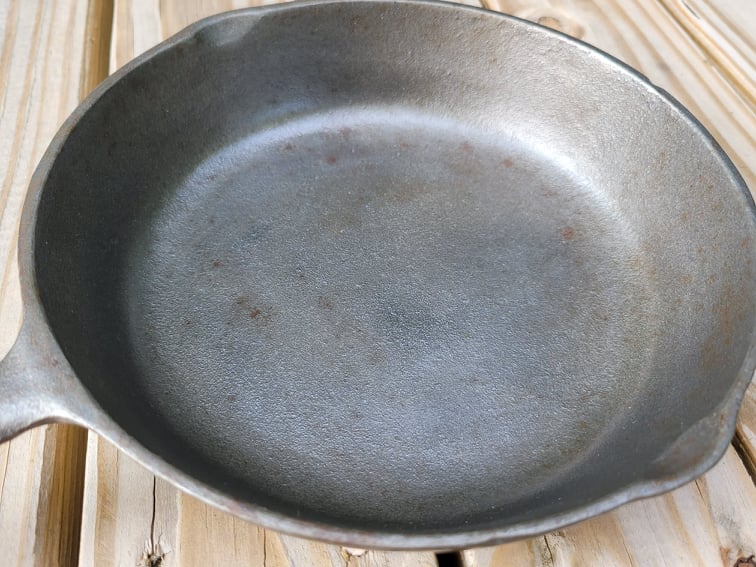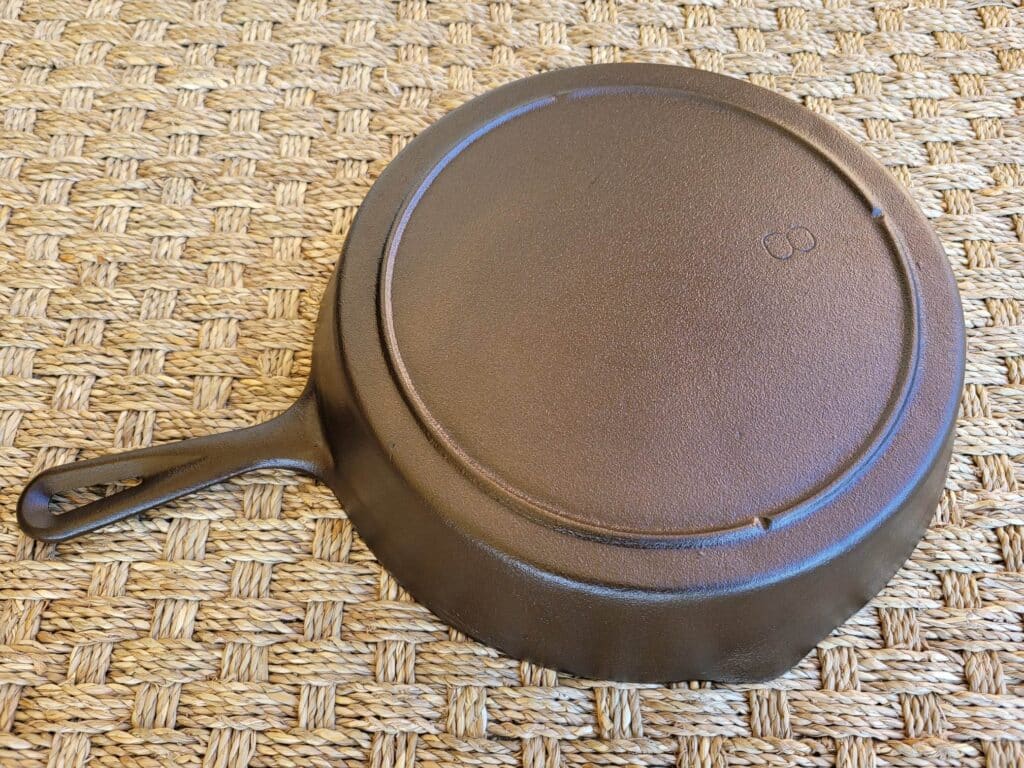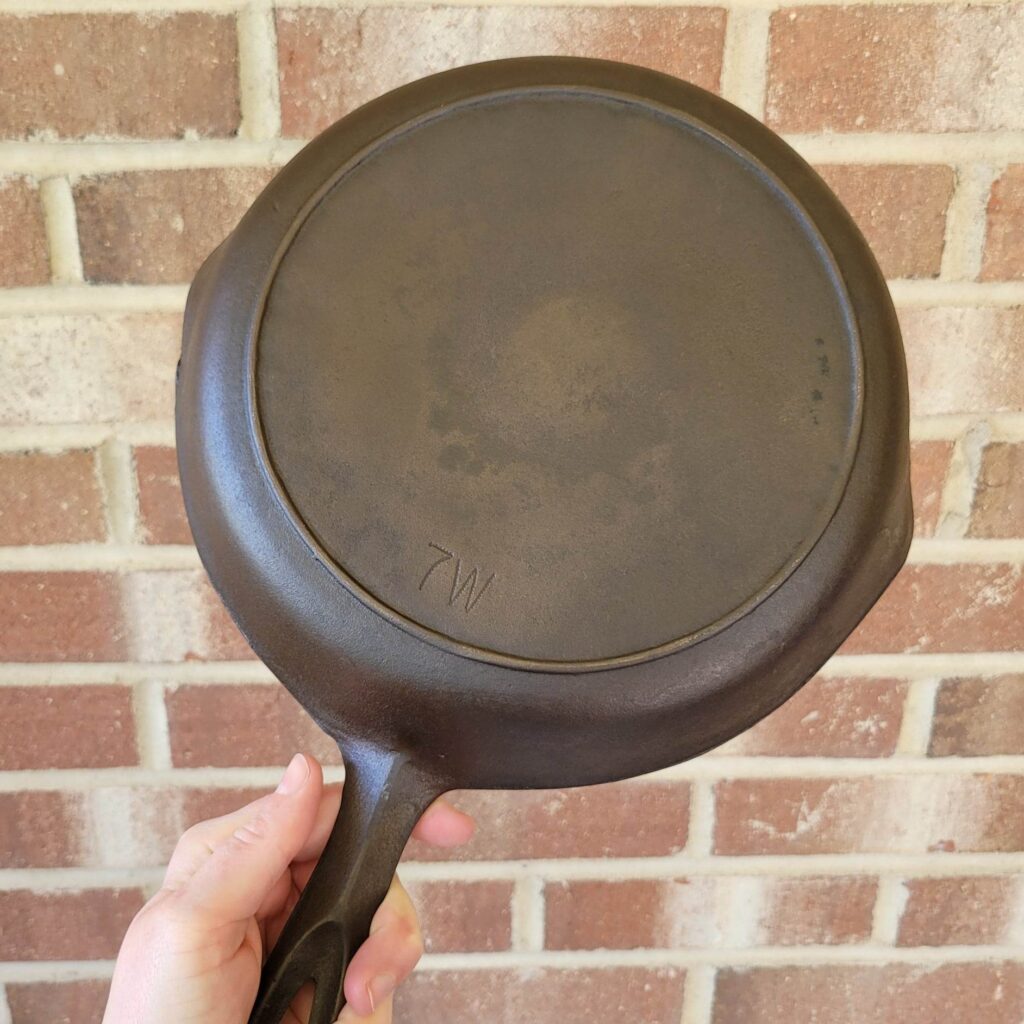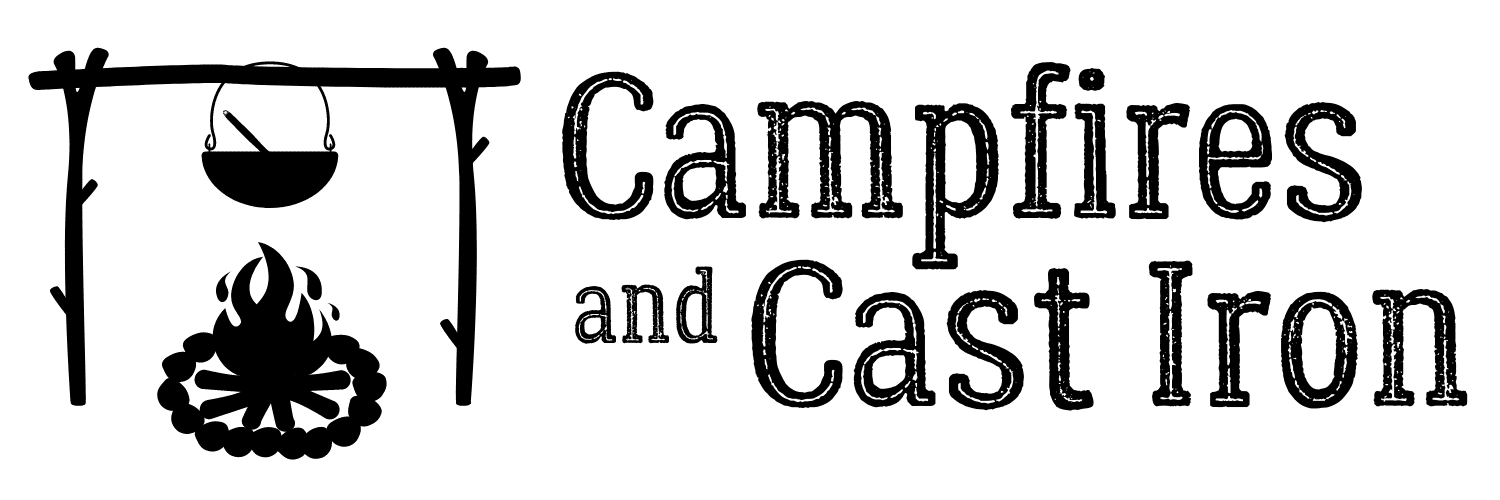Here are the answers to some commonly asked cast iron restoration questions:
Why Does My Cast Iron Look Bronze After Restoration?
After restoration, your cast iron may appear a dark bronze color instead of black.
When cast iron cookware is stripped down to bare metal, it is a silvery grey color. When oil is baked onto the pan during the initial seasoning process, it darkens to a bronze color. This is completely normal, and your pan will continue to get darker with use.



Why Do Some Areas Of My Cast Iron Look Uneven In Color?
Sometimes, cast iron cookware has areas of rust, pitting, staining, scratches, or utensil marks hidden under layers of old seasoning. When stripped down to bare metal, certain areas of the pan may look slightly lighter or darker.
Additionally, some pans aren’t completely even in color when they are manufactured due to differences in iron composition. This is especially true of older pieces of cast iron cookware.
The pictures below demonstrate how years of old seasoning and carbon buildup can stain cast iron. If your pan has visible differences in color after restoration, don’t worry. As you use it, the color will darken and become more even.


Can I Wash My Newly Restored Cast Iron With Dish Soap?
Yes! Washing your cast iron with mild dish soap is completely fine. We suggest using a plastic scraper tool to remove any stuck-on food. Then, wash your pan with a dish brush or non-abrasive sponge. The Scrub Daddy sponges (or any other brand of polymer sponges) work very well and won’t damage the pan’s seasoning layer.
For more information regarding soap and cast iron, see this article, “How To Safely Wash Cast Iron With Soap.”
Which Dish Soaps Are Best For Cast Iron?
These dish soaps are my top picks for washing cast iron cookware. They are gentle on the seasoning layer and do a good job of removing grease and food residue.
- Castile Soap (unscented)
- Caron & Doucet Cast Iron Soap
- ECOS Free & Clear Liquid Dish Soap
- Clark’s Cast Iron Soap
- Nature’s Promise Free & Clear Liquid Dish Soap
- Palmolive Pure + Clear Liquid Dish Soap
Dish Soaps To Avoid Using On Cast Iron
Here are some of the soaps I advise staying away from when washing cast iron. They’re just too strong and can damage or wear away the seasoning layer with repeated washes.
- Dawn Ultra, Platinum, or Powerwash
- Ajax Super Degreaser
- Palmolive Oxy Power Degreaser
- Joy Ultra Degreaser
- Gain Ultra Dishwashing Liquid
- Anything with the description “super,” “ultra,” or “power” degreaser
- Anything labeled as a “detergent”
It’s also a good idea to avoid using homemade soaps on your cast iron. If any unreacted lye remains in the soap, it can damage the seasoning layer.
Which Foods Are Best For Cooking In Newly Restored Cast Iron?
If you’re looking for a way to “break in” your newly restored cast iron skillet, dutch oven, or chicken fryer, baking cornbread is one of the best ways to do it.
Start by placing the pan in the oven, then preheat both to the recommended cooking temperature at the same time. Once preheated, carefully remove the pan, add your oil, add the prepared cornbread batter, and bake.
If cornbread isn’t your thing, try pan-frying any type of meat or vegetables in your cast iron with plenty of oil. The hot oil helps to continue building and strengthening the seasoning layer.
What Should I Avoid Cooking Until The Seasoning Layer Is Stronger?
Your cast iron pan’s seasoning layer will continue to improve over time. Although it has been seasoned multiple times during the restoration process, there are a few foods you may want to avoid cooking at first. Once your pan’s seasoning layer becomes stronger through regular use, it’s fine to cook all of these foods.
- Tomato-based sauces and soups
- Wine-based dishes
- Lean proteins, such as chicken breast or ground turkey
- Scrambled eggs
- Sugary foods or sauces, such as barbecue sauce or ketchup
- Starchy foods like potatoes or rice
- Simmering beans
- Boiling water
Which Oils Do You Recommend For Maintenance And Seasoning?
We prefer either grapeseed or high-quality canola oil for seasoning and maintaining your cast iron cookware. These oils are high in polyunsaturated fats, which allows them to bond better with cast iron and produce a stronger seasoning layer.
Avoid flaxseed oil for seasoning. It tends to produce a brittle seasoning layer that flakes off easily during cooking. Remember, flax = flakes.
How Do I Clean And Store My Cast Iron Pan After Use?
Cast iron cleaning and maintenance is really quite easy. Just follow these steps:
To clean cast iron after light use without food or grease residue, simply wipe the pan clean with a paper towel.
To clean cast iron after cooking:
- Use a plastic scraper tool to remove food scraps and grease.
- Wash the pan with warm water and mild dish soap, if desired.
- Dry the pan thoroughly with a towel.
- Apply a very light coat of oil to the cooking surface with a cloth or paper towel. Buff all the excess oil off of the pan as if you didn’t want it there in the first place. This will prevent your cast iron from getting sticky or smelling bad due to excessive oil build-up.
- Store cast iron cookware in a dry location, such as on the stovetop or in a cabinet.
Questions or Concerns?
If you have any cast iron restoration questions that weren’t answered here, feel free to contact us:
Email: campfiresandcastiron01@gmail.com
Phone: (336) 554-1218
This post may contain affiliate links. This means if you click on a link and make a purchase, I will receive a small commission, at no cost to you, that makes it possible for me to keep the Campfires and Cast Iron site up and running. Please see our disclosure policy for details.

